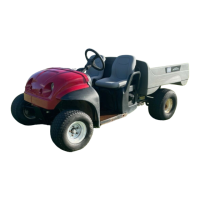Workman 1100/1110/2100/2110 Page 7 – 27 Chassis, Wheels, and Brakes (Rev. B)
Removal (Fig. 18)
1. Park machine on a level surface, stop engine, set
parking brake, and remove key from the ignition switch.
WARNING
Before jacking up the machine, review and follow
Jacking Instructions in Chapter 1 – Safety.
2. Chock wheels not being jacked up. Lift rear wheel off
the ground using a jack, and place blocks beneath the
frame under the axle tube.
3. Remove five lug nuts, tire and wheel, and brake drum
from the wheel hub.
4. Remove cotter pin from the castle nut and transaxle
shaft. Remove castle nut, lock washer, and spacer from
the shaft. Remove the wheel hub from the shaft.
NOTE: The brake assembly can be removed from the
transaxle shaft for disassembly.
5. Remove brake assembly as follows:
A. Remove cotter pin and clevis pin securing the
cable bracket to the actuator lever (Fig. 19).
B. Remove four cap screws and flanged lock nuts
securing the anchor plate of the brake assembly to
the transaxle. Remove brake assembly from the
transaxle.
Installation (Fig. 18)
IMPORTANT:Brake actuator levers must be posi-
tioned above the transaxle mount. When positioned
correctly, actuator lever will point toward the rear of
the axle (Fig. 19).
1. If brake assembly was removed from axle, position
brake assembly to the transaxle. Secure backing plate
of the brake assembly to the transaxle with four cap
screws and flanged lock nuts. Torque screws to 20 ft–lb
(27 N–m).
2. Secure cable bracket to the actuator lever with clevis
pin and cotter pin (Fig. 19).
IMPORTANT:Do not get antiseize lubricant onto
brake shoes.
3. Apply light coat of antiseize lubricant to the transaxle
shaft splines.
4. Secure wheel hub to the shaft with spacer, lock
washer, and castle nut.
5. Torque castle nut to the shaft between 120 to 200 ft–
lb (163 to 271 N–m) while aligning nut to hole in shaft.
Install cotter pin.
6. Slide brake drum onto wheel hub.
7. Position wheel assembly to the machine with valve
stem facing out and secure with five lug nuts. Torque lug
nuts in a criss–cross pattern from 45 to 65 ft–lb (61 to 88
N–m).
8. Lower machine to ground.
CAUTION
After servicing the brakes, always check the
brakes in a wide open, level area that is free of
other persons and obstructions.
9. Check and adjust brakes (see Brake Adjustment).
Burnish Brake Shoes
Sintered metal linings may not provide maximum brake
stopping distance after brake shoes are replaced. It is
necessary to burnish new brake shoe linings.
IMPORTANT:Do not drive machine with the brakes
applied. The brake shoe linings will overheat.
IMPORTANT:Do not allow the brakes to lock up. Al-
low brakes to cool between applications.
1. Drive machine while making 6 to 7 normal stops at
about 200 ft (60 m) intervals while traveling at 10 to 15
mph (16 to 24 KPH).
2. Make several normal stops with the machine going
in the reverse direction. This will self adjust the clear-
ance between the brake shoe and drum.
1. Cotter pin
2. Clevis pin
3. Brake cable bracket
4. Actuator lever
Figure 19
3
2
1
4
and Brakes
Chassis, Wheels,

